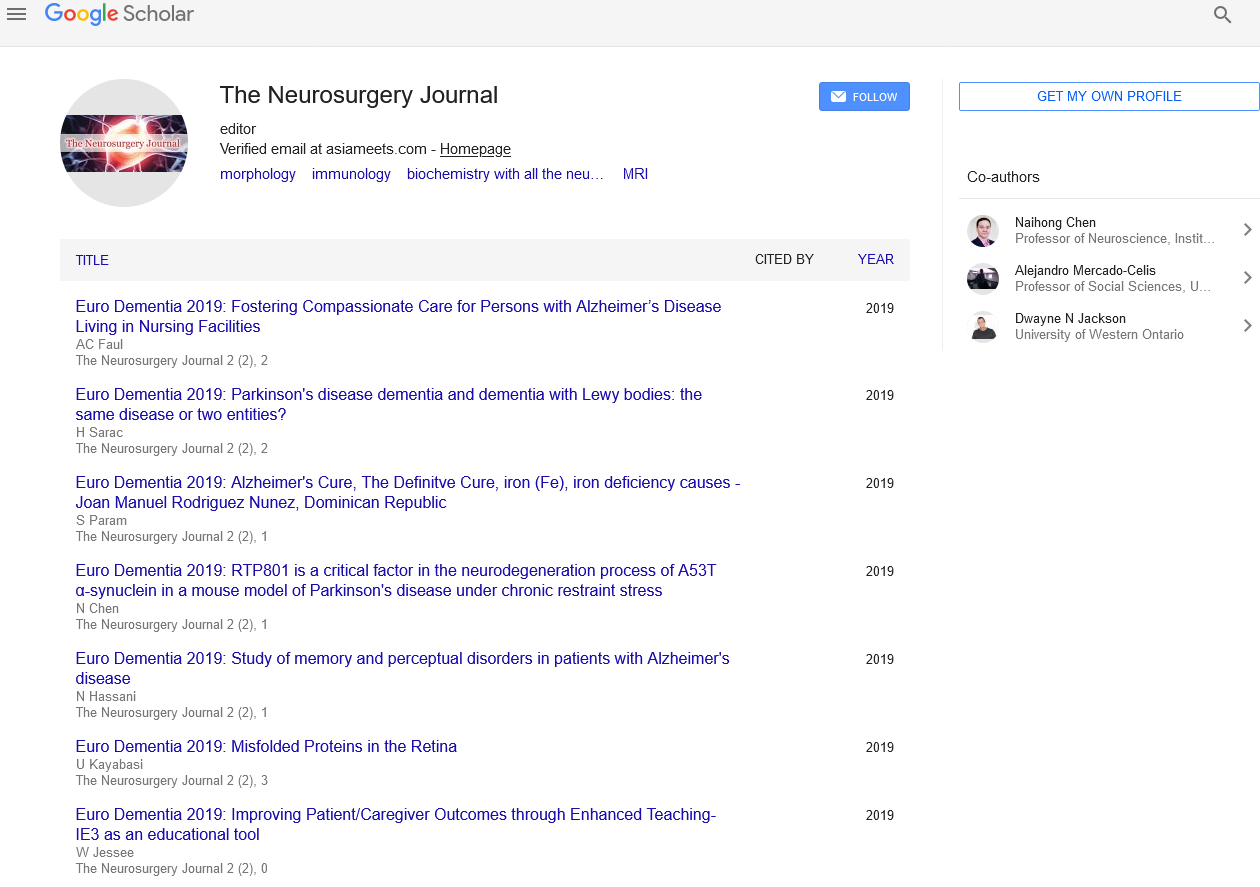brief note on parkinsons disease
Received: 06-Aug-2021 Accepted Date: Aug 20, 2021; Published: 27-Aug-2021
Citation: Salgado H. Brief note on parkinsons disease. Neurosurg J. 2021;4(1): 3
This open-access article is distributed under the terms of the Creative Commons Attribution Non-Commercial License (CC BY-NC) (http://creativecommons.org/licenses/by-nc/4.0/), which permits reuse, distribution and reproduction of the article, provided that the original work is properly cited and the reuse is restricted to noncommercial purposes. For commercial reuse, contact reprints@pulsus.com
Description
Parkinson's Disease (PD), or simply Parkinson's, is a prolonged degenerative disorder of the central nervous system that predominantly influences the motor system. The symptoms usually appear slowly, and as the disease deteriorates, non-motor symptoms become more common. Cognitive and behavioral difficulties may also occur with depression, anxiety, and apathy that occurs in many people with PD. Parkinson's disease dementia becomes common in the progressive stages of the disease. The motor symptoms of the disease affect the death of cells within the nucleus nigra, a neighborhood of the midbrain that ends in the loss of dopamine. The cause of this cell death is poorly recognized but involves the spread of misfolded proteins into Lewy bodies in the neurons. Altogether, the principal motor symptoms are also known as Parkinsonism or Parkinsonian syndrome.
Parkinson's disease signs and symptoms can differ from one individual to another. Early signs may be mild and cannot be recognized. Symptoms usually begin on one side of your body and typically remain worse thereon side, despite symptoms begin to affect each side.
Signs and symptoms may include:
• Tremors that usually occur in limbs and fingers.
• Slowed movement (bradykinesia).
• Rigid muscles may occur in any part of the body which is painful.
• Impaired posture and balance.
• Loss of ability to perform automatic movements.
• Slurred Speech.
• Difficulty in writing.
• Anosmia.
• Insomnia due to restless legs.
• Dementia.
The explanation for paralysis agitans is unknown, but several factors appear to play a task, including:
• Low dopamine levels.
• Low norepinephrine levels.
• Lewy bodies.
• Genetic factors.
• Auto-immune disorders such as Rheumatoid arthritis.
• Vulnerable to pesticides.
Parkinson’s disease varies in different people in various ways. Hardly everyone will have identical symptoms at the same severity, in the same order. Though there is a specific pattern of advancement that has been distinguished in Parkinson’s disease. On the whole, this disease has five stages.
1. Stage one: In the initial stage, the person may come across mild symptoms such as tremors and retardants in movement that occur on one side of the body only. Here, in this stage, the symptoms are unnoticeable which means the physician could not do proper diagnosis and ask the person to wait if the symptoms progress.
2. Stage two: At this stage, the symptoms get progressively worse where it affects both sides of the body. But the person could be able to perform daily activities which are somewhat difficult. Here, in this stage, the symptoms can be noticed by slowness or lack of voluntary movements but this a quite confusing with normal symptoms of agedness.
3. Stage three: Also known as the mid-stage of PD and the most noticeable symptoms are – difficulty in maintaining balance, repeatedly falling, and slowness. Here, in this stage, there is no doubt about the diagnosis. Though the person is still able to live independently but become very slow in performing their regular activities. The physician prescribes medicines in combination along with occupational therapy that helps to reduce symptoms.
4. Stage four: This stage is somewhat threatening to the patient to live alone. The individual requires support to move around such as a walker.
5. Stage five: This stage is the progress and paralyzing of Parkinson’s disease. During this stage, a person may require a wheelchair and be entirely bedridden. Here in this stage, the person has vulnerable to fall. During this stage, a person may feel hallucinations or suffer from delusions and paranoia.
There is no specific treatment in order to cure Parkinson’s disease, but can be managed by using some medications as prescribed/advised by the physician and also can control by physical therapy that helps in balance and also exercise that helps in managing PD.
There are not any specific diagnostic tests to diagnose paralysis agitans. A neurologist will diagnose based on the individual's medical history, signs, and symptoms, and physical assessment and advice to take certain tests such as blood tests, to eliminate other conditions that may be causing your symptoms and MRI, ultrasound of the brain, SPECT and PET scans to help in excluding other disorders.
Risk factors for PD include:
• Age - Adolescents rarely experience Parkinson's disease. It usually begins in middle or adulthood, and the risk eventually increases with age. In general, an individual may develop the disease at about age 60 or older.
• Heredity - Based on family history there are chances of development in PD.
• Sex - Males are more prone to PD than females.
• Exposure to toxins – Persistent exposure to herbicides and pesticides may somewhat increase the risk of Parkinson's disease to the person.





